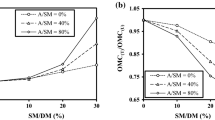Abstract
Flotation separation and recovery of value minerals from ores containing fibrous silicate minerals are known to be quite challenging. Earlier studies have established that the metallurgical challenges (poor selectivity and recovery, high energy consumption, etc.) arise from the impact of the fibrous minerals (with high aspect ratio) on pulp rheology, which was found be rather complex. The complex rheological behavior of ore suspensions containing particles with high aspect ratio and its influence on flotation outcome are investigated in this study. Flotation tests and rheological measurements were carried out with both ores (containing fibrous minerals) and a model system comprising nylon fibers (chemically inert) added to a copper ore that had no fibrous mineral. These studies allowed the determination of contributions of physical properties of the fiber to pulp rheological behavior. Optical microscopy images of the fiber pulp indicated that the fibers entangled to form two levels of microstructures: two-dimensional (2D) aggregates under semi-dilute (< 20% solids) conditions and three-dimensional (3D) microstructures at concentrations > 30% solids. The yield stress (σ) values determined for the fiber pulp were logarithmically related to the volume fraction of the 2D/3D structures. The relationships developed here for different ARs showed that the yield stress of a flotation pulp changes with respect to shape, size, and the concentrations of the microstructures. Implications to the effects of such entangle networks on selectivity of flotation separation are discussed.






Similar content being viewed by others
References
Schmid CF, Switzer LH, Klingenberg DJ (2000) Simulations of fiber flocculation: effects of fiber properties and interfiber friction. J Rheol 44:781–809. https://doi.org/10.1122/1.551116
Bennington CPJ, Azevedo G, John DA, Birt SM, Wolgast BH (1995) The yield stress of medium- and high-consistency mechanical pulp suspensions at high gas contents. J Pulp Paper Sci 21(4):111–118
Mason SG (1950) The flocculation of pulp suspensions and the formation of paper. TAPPI J 33:440–444
Schmid CF, Klingenberg DJ (2000a) Mechanical flocculation of flowing fiber suspensions. Phys Rev Lett 84:290–293. https://doi.org/10.1103/PhysRevLett.84.290
Kerekes RJ, Schell CJ (1992) Characterization of fiber flocculation regimes by a crowding factor. J Pulp Paper Sci 18:J32–J38
Eltham JA, Tilyard PA, (1973) An approach to the flotation of Western Australian Ni ores, Proceedings, Australasian Institute of Minerals and Metallurgy Annual Conference, Western Australia, 417–429
Edwards CR, Kipkie WB, Agar GE (1980) The effect of slime coatings of the serpentine minerals, chrysotile and lizardite, on pentlandite flotation. Int J Miner Process 7:33–42. https://doi.org/10.1016/0301-7516(80)90035-6
Rinaudo C, Gastaldi D, Belluso E (2003) Characterization of chrysotile, antigorite and lizardite by FT-Raman spectroscopy. Can Mineral 41(4):883–890. https://doi.org/10.2113/gscanmin.41.4.883
Patra P, Bhambhani T, Vasudevan M, Nagaraj DR, Somasundaran P (2012) Transport of fibrous gangue mineral networks to froth by bubbles in flotation separation. Int J Miner Process 104-105:45–48. https://doi.org/10.1016/j.minpro.2011.11.007
Patra P, Nagaraj DR, Somasundaran P, (2010) Impact of pulp rheology on selective recovery of value minerals from ores, XI international seminar on mineral processing technology, 15–17 December, NML, Jamshedpur, India
Fitzpatrick EA (1993) Soil microscopy and micromorphology. John Wiley and Sons, New York ISBN-10: 0471938599
Doi M, Edwards SF (1986) The theory of polymer dynamics. Clarendon Press, Oxford ISBN: 9780198520337
Doi M, Edwards SF (1978) Dynamics of rod-like macromolecules in concentrated solution: part 1, J Chem Soc, Faraday Trans 2, (74), 560–570. https://doi.org/10.1039/F29787400560
Acknowledgements
The authors acknowledge the support of Manqiu Xu, Zongfu Dai, Andrew Lee, and Ken Scholey at the Vale Technical Services in Mississauga, Canada. The authors acknowledge the support received for this research work from the National Science Foundation Industry/University Collaborative Research Center of Particulate and Surfactant Systems (IIP 1362078).
Author information
Authors and Affiliations
Corresponding author
Ethics declarations
Conflict of Interest
The authors declare that they have no conflict of interest.
Rights and permissions
About this article
Cite this article
Somasundaran, P., Patra, P., Bhambani, T. et al. Rheology of ore suspensions with fibrous minerals and its impact on flotation performance. Mining, Metallurgy & Exploration 36, 111–116 (2019). https://doi.org/10.1007/s42461-018-0040-8
Received:
Accepted:
Published:
Issue Date:
DOI: https://doi.org/10.1007/s42461-018-0040-8




